Abstract
Pseudomonas syringae inocula containing cell concentrations ranging from 105 to 109 cells per ml were applied to the primary leaves of bean plants. The plants were incubated under conditions of high temperature and illumination and low relative humidity. Bacterial mortality rates and the proportional population decline of the inoculum were lowest at the highest inoculum concentrations. Addition of a high concentration of heat-killed cells to the inoculum containing a low concentration of viable cells significantly reduced both the mortality rate and the proportional population decline of the viable cells. The mechanisms underlying this density-dependent mortality may include cooperative protective effects of extracellular factors, such as bacterial extracellular polysaccharides, and physical protection by neighboring cells. Although epiphytic populations derived from inoculum concentrations of 108 or 109 cells per ml tended toward 106 CFU/g, the presumed carrying capacity of the leaf, populations derived from lower inoculum concentrations never achieved this carrying capacity. Assuming that epiphytic populations of P. syringae reside in discrete protected sites, our results suggest that at low inoculum concentrations, following a period of environmental stress, the number of viable cells may have dropped to zero in some sites; hence, the carrying capacity of the leaf could not be achieved.
Full text
PDF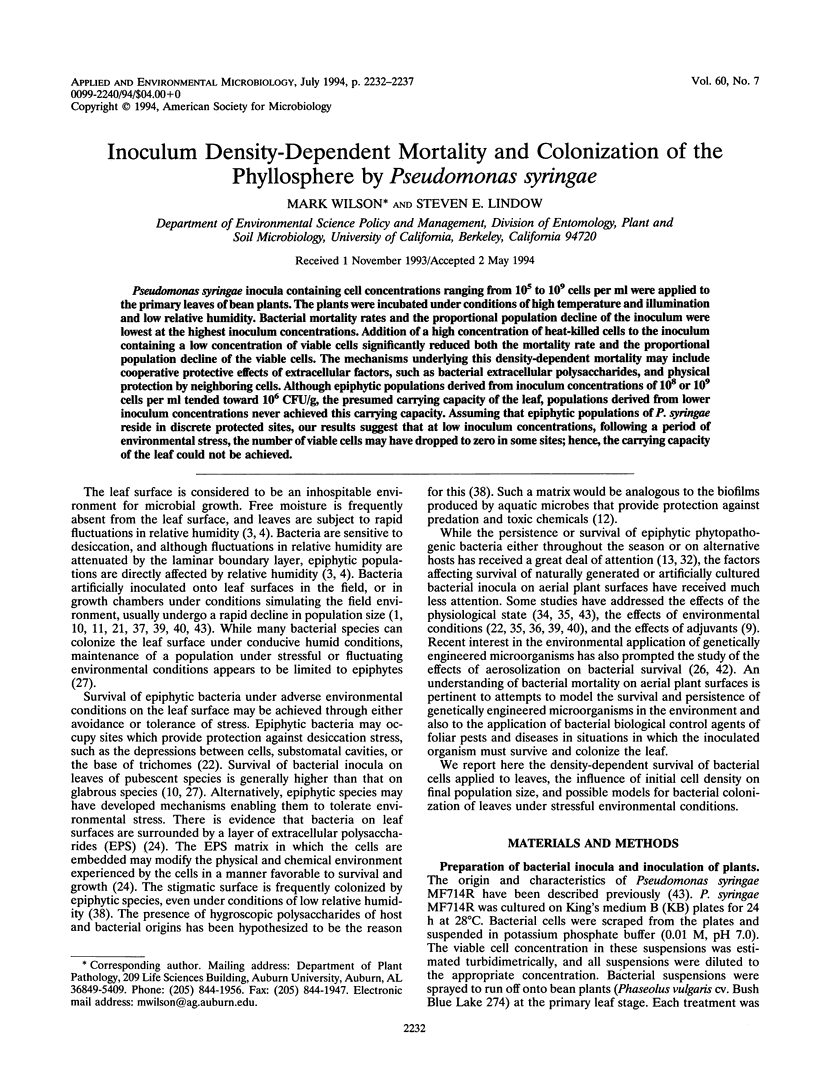
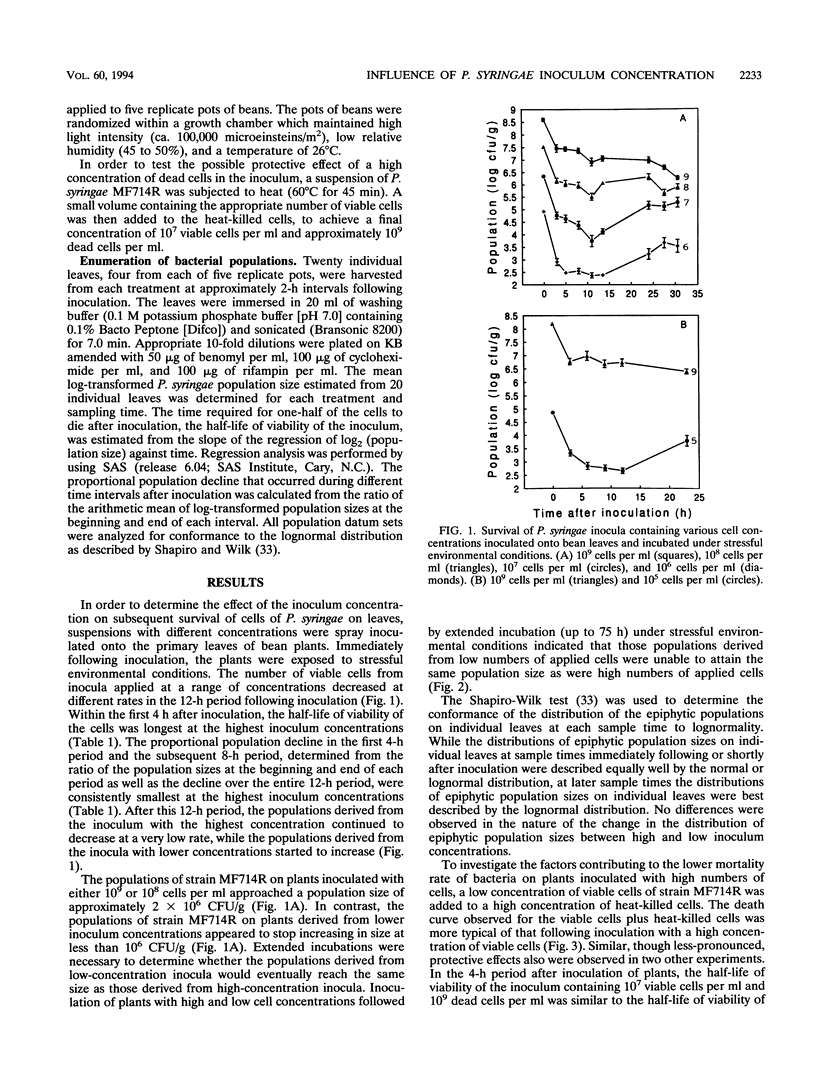
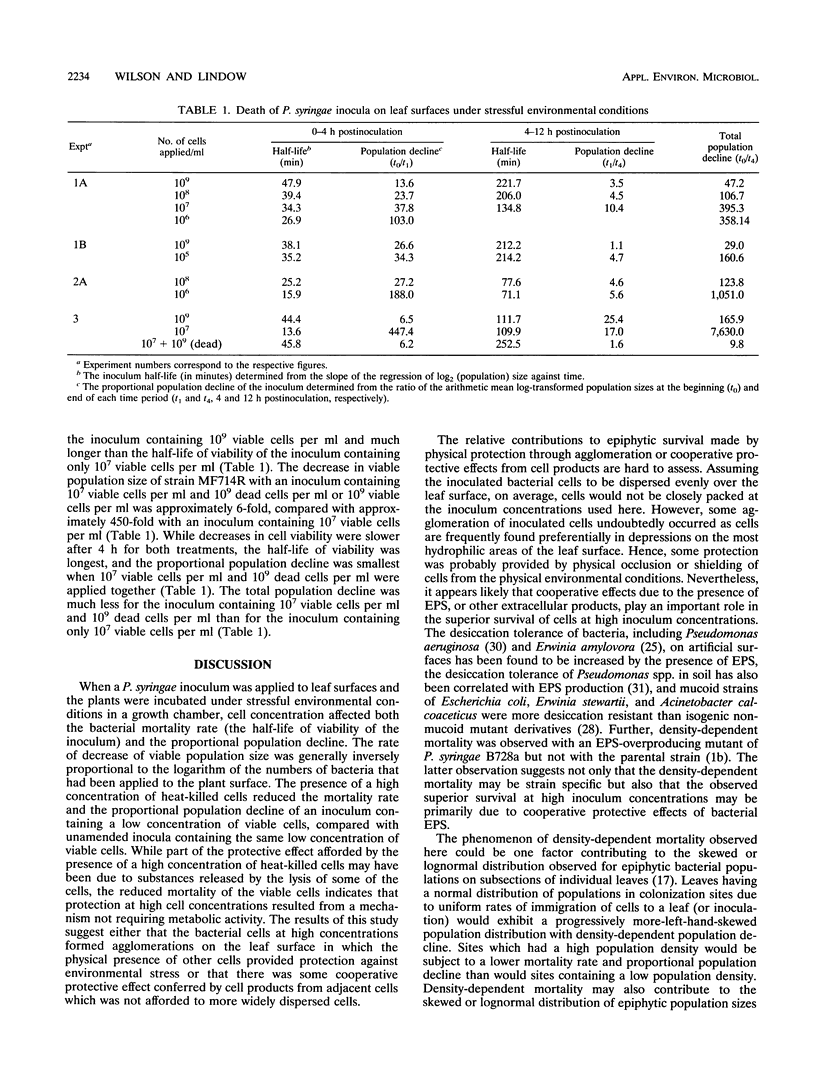
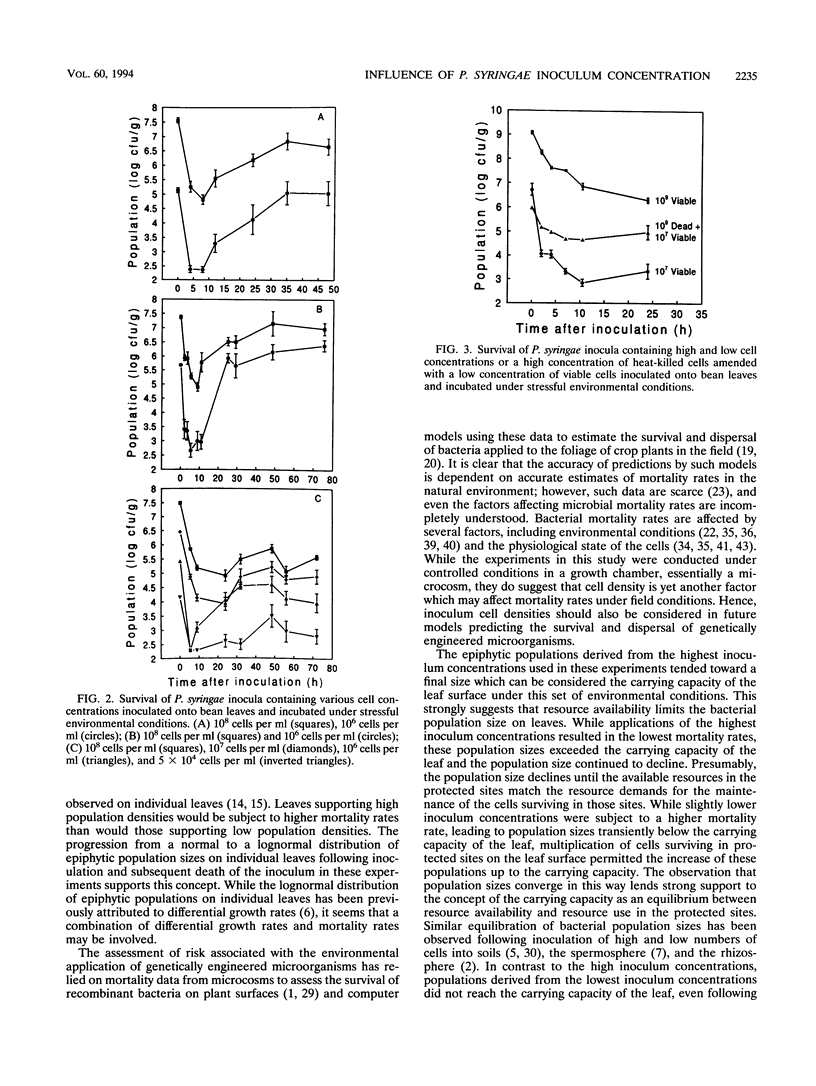
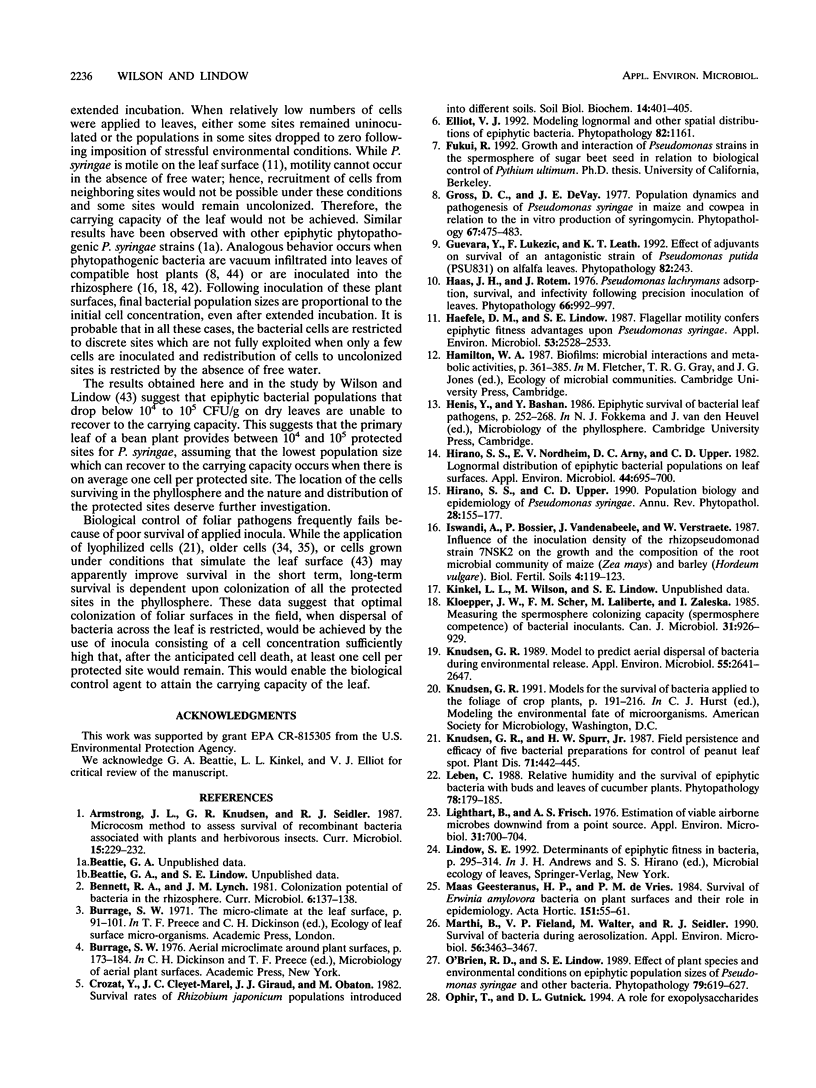
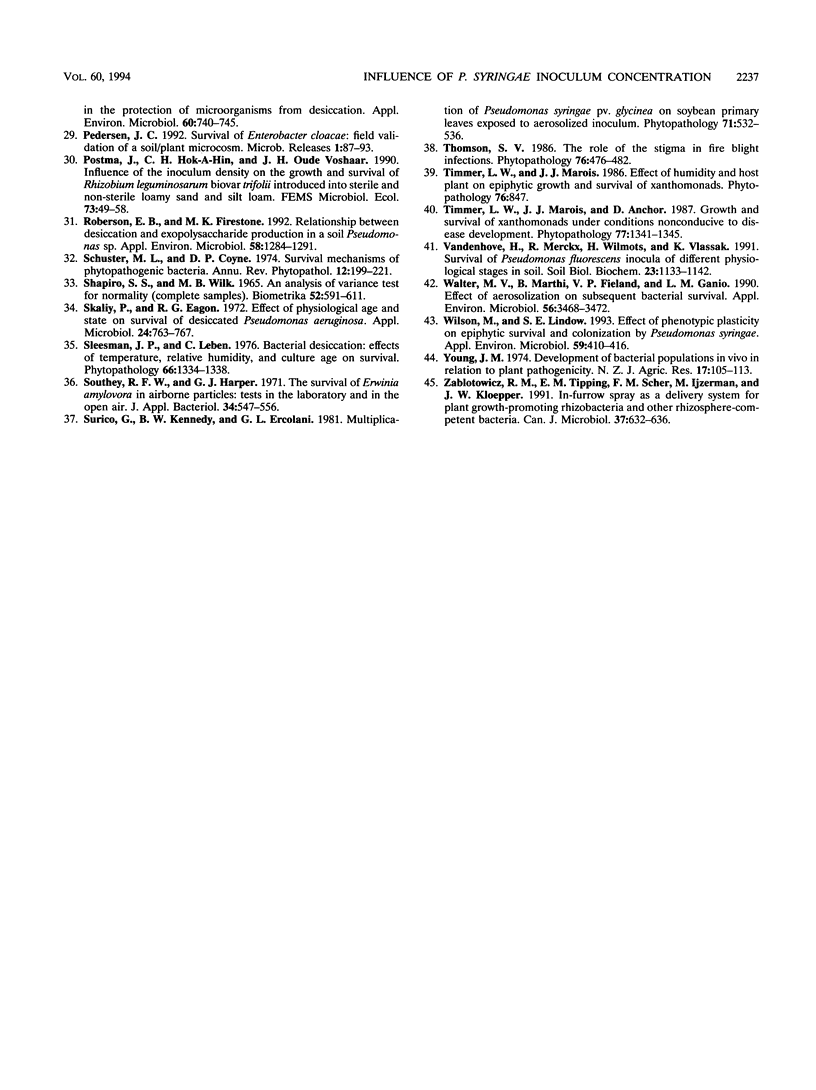
Selected References
These references are in PubMed. This may not be the complete list of references from this article.
- Haefele D. M., Lindow S. E. Flagellar Motility Confers Epiphytic Fitness Advantages upon Pseudomonas syringae. Appl Environ Microbiol. 1987 Oct;53(10):2528–2533. doi: 10.1128/aem.53.10.2528-2533.1987. [DOI] [PMC free article] [PubMed] [Google Scholar]
- Hirano S. S., Nordheim E. V., Arny D. C., Upper C. D. Lognormal distribution of epiphytic bacterial populations on leaf surfaces. Appl Environ Microbiol. 1982 Sep;44(3):695–700. doi: 10.1128/aem.44.3.695-700.1982. [DOI] [PMC free article] [PubMed] [Google Scholar]
- Kloepper J. W., Scher F. M., Laliberté M., Zaleska I. Measuring the spermosphere colonizing capacity (spermosphere competence) of bacterial inoculants. Can J Microbiol. 1985 Oct;31(10):926–929. doi: 10.1139/m85-173. [DOI] [PubMed] [Google Scholar]
- Knudsen G. R. Model to predict aerial dispersal of bacteria during environmental release. Appl Environ Microbiol. 1989 Oct;55(10):2641–2647. doi: 10.1128/aem.55.10.2641-2647.1989. [DOI] [PMC free article] [PubMed] [Google Scholar]
- Lighthart B., Frisch A. S. Estimation of viable airborne microbes downwind from a point source. Appl Environ Microbiol. 1976 May;31(5):700–704. doi: 10.1128/aem.31.5.700-704.1976. [DOI] [PMC free article] [PubMed] [Google Scholar]
- Marthi B., Fieland V. P., Walter M., Seidler R. J. Survival of bacteria during aerosolization. Appl Environ Microbiol. 1990 Nov;56(11):3463–3467. doi: 10.1128/aem.56.11.3463-3467.1990. [DOI] [PMC free article] [PubMed] [Google Scholar]
- Ophir T., Gutnick D. L. A role for exopolysaccharides in the protection of microorganisms from desiccation. Appl Environ Microbiol. 1994 Feb;60(2):740–745. doi: 10.1128/aem.60.2.740-745.1994. [DOI] [PMC free article] [PubMed] [Google Scholar]
- Roberson E. B., Firestone M. K. Relationship between Desiccation and Exopolysaccharide Production in a Soil Pseudomonas sp. Appl Environ Microbiol. 1992 Apr;58(4):1284–1291. doi: 10.1128/aem.58.4.1284-1291.1992. [DOI] [PMC free article] [PubMed] [Google Scholar]
- Skaliy P., Eagon R. G. Effect of physiological age and state on survival of desiccated Pseudomonas aeruginosa. Appl Microbiol. 1972 Nov;24(5):763–767. doi: 10.1128/am.24.5.763-767.1972. [DOI] [PMC free article] [PubMed] [Google Scholar]
- Walter M. V., Marthi B., Fieland V. P., Ganio L. M. Effect of aerosolization on subsequent bacterial survival. Appl Environ Microbiol. 1990 Nov;56(11):3468–3472. doi: 10.1128/aem.56.11.3468-3472.1990. [DOI] [PMC free article] [PubMed] [Google Scholar]
- Wilson M., Lindow S. E. Effect of phenotypic plasticity on epiphytic survival and colonization by Pseudomonas syringae. Appl Environ Microbiol. 1993 Feb;59(2):410–416. doi: 10.1128/aem.59.2.410-416.1993. [DOI] [PMC free article] [PubMed] [Google Scholar]


